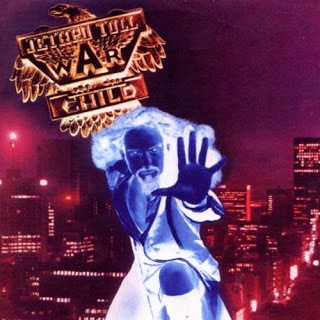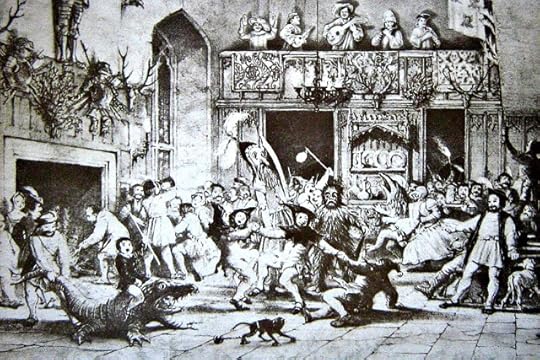War Child and Minstrel in the Gallery - Tull
 War Child is Jethro Tull's most orchestrated album, making good use of a string quartet (the Ladies in Platinum Wigs' would join them on tour over the next couple of years), so a large portion of the LP’s success is attributed to Tull's orchestral arranger - future band member David Palmer. That's not to belittle the band's contribution to the project, as here they demonstrate why they were highly respected by a range of other musicians from diverse genres. Of particular note is Martin Barre's hard edged guitar work, which erupts through the stately strings with impressive results. Again, Anderson played saxophones as well as his flutes and guitars. War Child also finds Anderson at the height of his powers as a vocalist, something for which he seems to get very little credit for.
War Child is Jethro Tull's most orchestrated album, making good use of a string quartet (the Ladies in Platinum Wigs' would join them on tour over the next couple of years), so a large portion of the LP’s success is attributed to Tull's orchestral arranger - future band member David Palmer. That's not to belittle the band's contribution to the project, as here they demonstrate why they were highly respected by a range of other musicians from diverse genres. Of particular note is Martin Barre's hard edged guitar work, which erupts through the stately strings with impressive results. Again, Anderson played saxophones as well as his flutes and guitars. War Child also finds Anderson at the height of his powers as a vocalist, something for which he seems to get very little credit for. Just a Reminder of the Chrysalis Green CassetteFor this project, Anderson's songwriting lightened somewhat since A Passion Play, which, given the fact that they deal with the same subject is intriguing. His patented sense of humor had returned as well, as songs like "Sealion" and "Bungle In The Jungle" demonstrate. Also benefiting from the injection of a sense of humor is "Two Fingers," which was the latest in a series of killer closing tracks for Tull albums. "Two Fingers" also demonstrated Anderson's ability to recycle previously discarded material, as the lyrics are largely taken from Tull's never released "Lick Your Fingers Clean" single. The arrangement and mood is quite different to the early rocking-prototype, but that doesn't prevent it being utterly superb and one of Tull's best songs. Another two tracks that were salvaged from abandoned material are "Skating Away On The Thin Ice Of A New Day" and "Only Solitaire," songs that were originally cut during the Chateau D'Isaster sessions, but put on ice in favor of A Passion Play. Again, the material was too good to be lost for any great length of time.
Just a Reminder of the Chrysalis Green CassetteFor this project, Anderson's songwriting lightened somewhat since A Passion Play, which, given the fact that they deal with the same subject is intriguing. His patented sense of humor had returned as well, as songs like "Sealion" and "Bungle In The Jungle" demonstrate. Also benefiting from the injection of a sense of humor is "Two Fingers," which was the latest in a series of killer closing tracks for Tull albums. "Two Fingers" also demonstrated Anderson's ability to recycle previously discarded material, as the lyrics are largely taken from Tull's never released "Lick Your Fingers Clean" single. The arrangement and mood is quite different to the early rocking-prototype, but that doesn't prevent it being utterly superb and one of Tull's best songs. Another two tracks that were salvaged from abandoned material are "Skating Away On The Thin Ice Of A New Day" and "Only Solitaire," songs that were originally cut during the Chateau D'Isaster sessions, but put on ice in favor of A Passion Play. Again, the material was too good to be lost for any great length of time. War Child demonstrates Tull's ability to merge genres to good effect, as evidenced on the often overlooked "The Third Hoorah" which incorporates rock, Elizabethan folk, a military marching band and classical structures. Like I said, it's heady stuff.
The reason Tull warrants continued discussion is that, unlike just about all other prog rock acts of the mid-‘70s, they were - in their businesslike, seemingly obligatory fashion - cranking out one masterful effort each year. By 1975, progressive rock was on its way to the dinosaur pit. Pink Floyd had released arguably their most cohesive and satisfying album, Wish You Were Here, but many other acts from core years were on the ropes, running out of steam or gone altogether. Yes was on hiatus, Emerson, Lake & Palmer and The Moody Blues were mere shells of their former glory, and King Crimson had called it quits. Genesis soldiered on, with Trick and Wuthering and made a string of respectable albums with Collins at the helm (and then a longer string of increasingly commercial, successful albums), though many would agree that things were not the same once Peter Gabriel rolled up his freak flag and went it alone.
All that in mind, Jethro Tull were the kings of the hill, in terms of consistency and quality, even in late '75 . The benefit of hindsight makes their proficiency, and the quality of the work, more obvious. Where some (much?) of the material from prog's heyday is decidedly of its time (for better or worse) and, lyrically, is often acknowledged with a wink and a shrug, Jethro Tull's work in general, and on Minstrel in the Gallery in particular, needs no defense nor any nostalgia to be appreciated. Minstrel has less of the sneering post-adolescent angst and rage and more of the wizened perspective of an adult who has toured the world, seen some things and is able to comment accordingly.

Discussion of Anderson's lyrical prowess is inevitable, and appropriate, and mentioned in previous reviews. Where he did not shy away from autobiographical elements (especially on Benefit), his specialty was linking the personal with a reporter's eye for both absurdity and the universal (think Aqualung); on Thick as a Brick he displayed a sociologist's eye for societal mores, and in his inimitably impish way, took his sledgehammer to all manner of very British sacred cows (class, religion, etc.); whereas on A Passion Play and War Child he used every tool in his musical and intellectual arsenal, essentially summing up all the LPs which preceded them (if arguably not as well).

On Minstrel in the Gallery, we have less of the sneering post-adolescent angst and rage and more of the wizened perspective of an adult who has toured the world, seen some things and is able to comment accordingly. The opening 8-minute-plus title cut has a minstrel-folk intro that then gives way to a classic hard rocker with some tasty guitar from Barre. Next is "Cold Wind to Valhalla," which starts out like a renaissance era folk tune but then turns into a hard but bluesy rocker (which has Barre doing both lead guitar and some great slide). Excellent use of violins in this song aid the thoughtful orchestration, just as it had done on Warchild. Who said strings and rock don't mix. Next is another classic, the epic "Black Satin Dancer" which features some hard rock riffs and the trademark Anderson folk influences. Its lyrics tell of sexual foreplay and intense longing.
The album's second side kicks off with another acoustic number called "One White Duck/0^10 = Nothing at All," s a great hook immersed in incredible musicianship. Next is the band's first 10-minute-plus track since the 1973 album-length epic A Passion Play, "Baker St. Muse." The song tells the story about a muse, a very down-to-earth fellow crying out that Jethro Tull wasn't the commercial group that War Child made them out to be. The lyrics state that we're still in the gutter singing about things that haven't changed. The other parts of the epic are stories of the street, likely stories of the "Baker St. Muse" (aka Jethro Tull). Each vignette is particularly sexual. Had they been released after 1986, they'd have a Parental Advisory label.
Published on August 03, 2018 04:23
No comments have been added yet.



